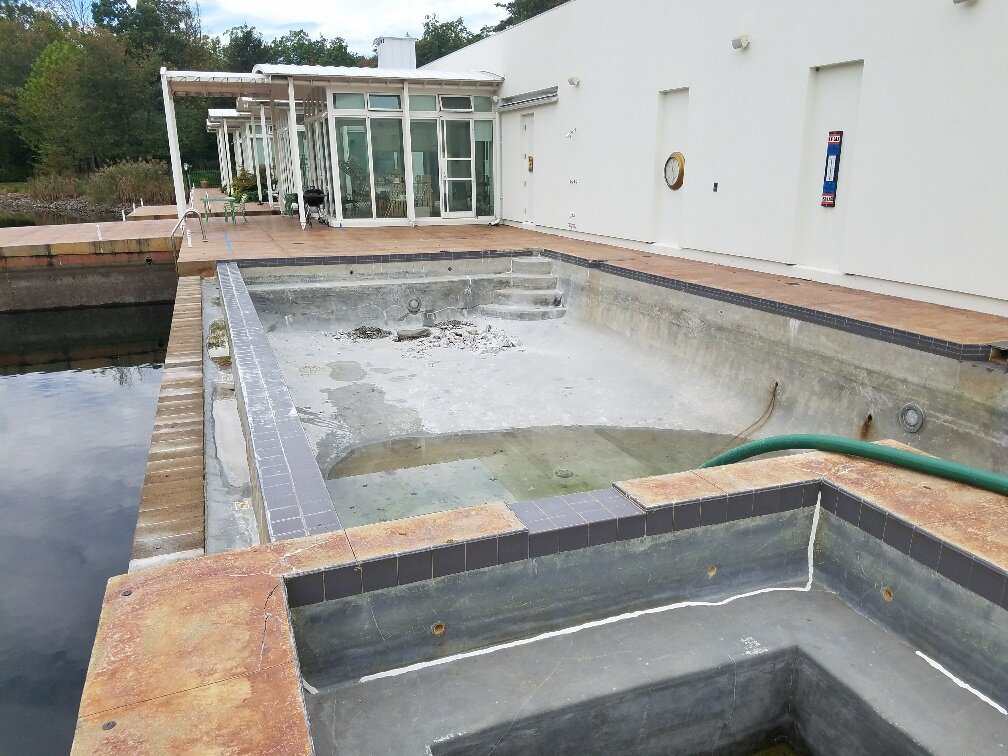Called back to a pool he’d bid on unsuccessfully ten years earlier, William Drakeley found that the winning contractor had fallen short in several ways. It was now up to him to persuade an extremely reluctant client to start all over again, this time with a more suitable approach.
As we were wrapping up a WaterShapes article called “Working at Water’s Edge” back in the fall of 2018, it occurred to me that there was another story to be told about a project highlighted in the text.
What we found - a breaking apart pool, cracked spa, and undersized trough.
In that article, one of the pools I’d written about was set up on the edge of a large, manmade lake. I briefly noted that I’d been called to the site as an expert witness after having seen the place several years earlier as a designer/builder who hadn’t won the contract. In this article, I’ll go back to my initial contacts with the client and tell a fuller story of a trying relationship that, slowly and with great difficulty, worked out for the best.
On the client’s part, it’s a tale about looking for a deal and getting in trouble with an obviously complicated project. For me, it was a great object lesson – and, I think, a useful cautionary tale for watershapers who encounter similarly challenging projects.
STRAIGHT TALK
Back in 2008 or ’09, the client found Drakeley Pool Company (Bethlehem, Conn.) through a reference that defined us as one of the area’s high-end design/build firms. He was a real estate executive from New York City and clearly not one who varnishes his opinion.
What we gave them - a new and properly engineered pool and spa.
In the process, he’d met with three or four companies, and by my recollection we’d distinguished ourselves by insisting on the need for soils research and geotechnical analysis, given that the pool was to be set in a narrow space between the house and a seawall. We were familiar with the property manager and the home builder through other projects and figured they’d see and support the wisdom of our conservative approach.
Once we presented initial budget numbers and a game plan, I took the clear impression that the client stopped listening. Maybe he had decided to disregard the caliber or reliability of our work? More likely, perhaps he had a set figure in his head that we’d surpassed by too much?
Our portfolio was impressive, but this gentleman had lived for years in the rough-and-tumble world of New York realty. As a result, I believed he had little faith that what we said the project would involve and what it would cost was realistic.
Although we were under the impression after our meeting that we weren’t the right fit, we followed up by phone and email as a courtesy. When no response was forthcoming, we took him off our prospect list. We never heard from him or anyone else associated with the project again. Moreover, we weren’t even curious enough to try to get any information on the outcome. The whole matter slipped swiftly out of sight and out of mind.
Almost ten years passed, and the home builder called and asked me to come in as a consulting expert/design builder on a project that had gone south with a cracking pool that was only getting worse. As I mentioned, I had worked with this builder on other projects and didn’t realize that this was that old lakeside project until I pulled into the driveway and memories of my previous attempts flooded my thoughts.
I’d made the trip, so I met with the homeowner and the builder. Nothing had changed, with the homeowner declaring almost immediately that he wasn’t looking to break the bank on repairs and further reporting that the pool had been troubled from the very start.
Click here to continue reading this story on Watershapes Magazine’s website.

